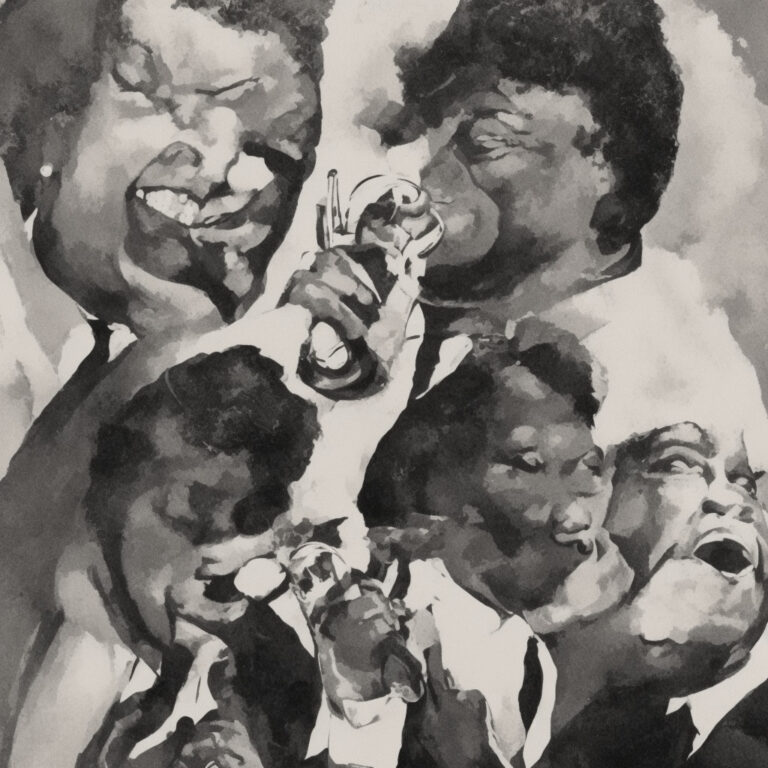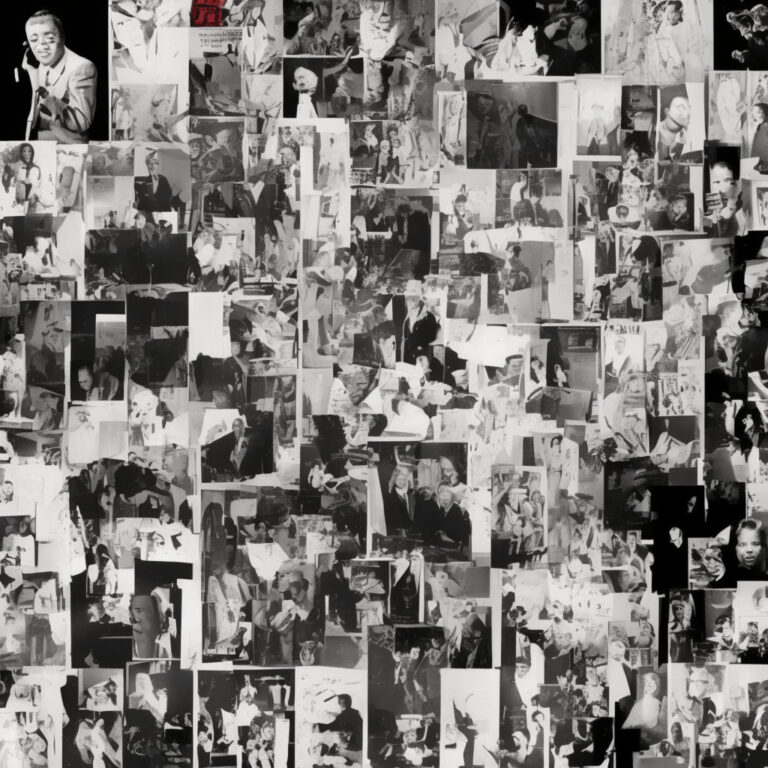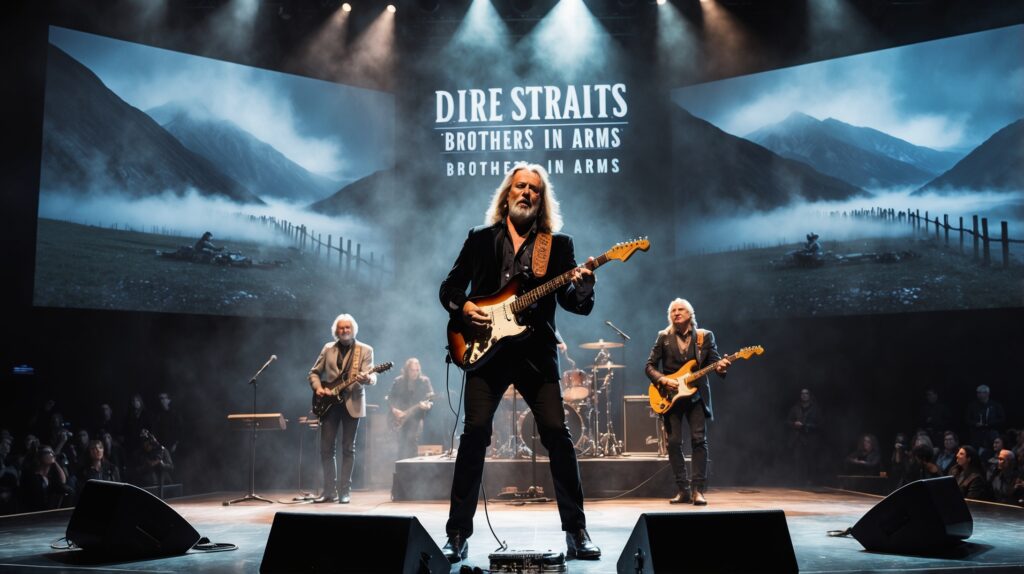🎶Ella & Louis’ timeless “Cheek to Cheek” turns 65!🎉 Did you know it was recorded in just ONE take?🤯 A match made in jazz heaven✨ #EllaAndLouis #JazzLegends #CheekToCheek #MusicTrivia Read about it: tinyurl.com/3ux8v9jd
A Timeless Collaboration: Ella Fitzgerald and Louis Armstrong
Jazz Royalty Unite: Ella Fitzgerald’s angelic voice and Louis Armstrong’s soulful rasp blend seamlessly in the timeless classic, “Cheek to Cheek.”

The combination of Ella Fitzgerald and Louis Armstrong is, without a doubt, one of the most incredible and timeless partnerships in the history of jazz. The two legendary musicians teamed up in 1956 to record their first collaborative album, Ella and Louis, which included the enchanting track “Cheek to Cheek.” Their individual talents alone were enough to cement their legacies, but together, they provided music enthusiasts with a blend of vocals and performance artistry that still captivates listeners today.
Ella Fitzgerald, known as the “First Lady of Song,” had a vocal range spanning three octaves and is widely recognized for her pure tone, impeccable diction, and exceptional ability to mimic instrumental sounds with her voice. In the early days of her career, she was a member of the Chick Webb Orchestra, and later became the leader of the band after Webb’s death. Over her six-decade-long career, Ella recorded over 200 albums, sold over 40 million copies, and claimed 14 Grammy Awards, including one for Lifetime Achievement in 1967.
On the other hand, Louis Armstrong, also known as “Satchmo” or “Pops,” was a trumpeter and vocalist, originating from New Orleans. Armstrong was recognized as one of the most influential figures in jazz history. Known for his inventive trumpet playing and unique gravelly voice, he had the ability to connect emotionally with his audience. In his five-decade-long career, he released hit after hit, such as “What a Wonderful World,” “When the Saints Go Marching In,” and “Hello, Dolly!” In 1972, Armstrong was posthumously awarded the Grammy Lifetime Achievement Award.
Now, let’s talk about their beautiful rendition of “Cheek to Cheek.” Originally composed by Irving Berlin for Fred Astaire and Ginger Rogers’ film Top Hat (1935), Ella and Louis’ version has become one of the definitive performances of the song. Their contrasting vocal styles – Ella’s sweet, smooth voice, and Louis’ raspy, soulful tone – complemented each other perfectly. Their recording of “Cheek to Cheek” showcases their undeniable chemistry, creating a playful and romantic atmosphere that has made the song a classic standard in the world of jazz.
It’s hard to criticize these two icons, but if there’s one thing some might argue, it’s that their collaborations might have overshadowed their individual careers. However, this is a small price to pay when considering the extraordinary musical legacy they left behind as a duo.
Ella Fitzgerald and Louis Armstrong’s collaboration was truly a match made in musical heaven. Their combined talents led to a plethora of accolades and awards, and their rendition of “Cheek to Cheek,” among other songs, will continue to enchant generations of music lovers for years to come.
Charting the Success of This Timeless Classic
Ella and Louis’ timeless “Cheek to Cheek”: an eternal masterpiece that transcends charts and continues to inspire artists across generations.

When Ella Fitzgerald and Louis Armstrong came together to record the iconic song “Cheek to Cheek,” they created a timeless masterpiece that has captivated audiences for decades. Released on April 1956, as part of their collaborative album “Ella and Louis,” it became an instant hit and has maintained its popularity to this day.
One of the most interesting pieces of trivia about “Cheek to Cheek” is that it was actually written by Irving Berlin back in 1935 for the Fred Astaire and Ginger Rogers movie, “Top Hat.” The original version by Fred Astaire peaked at No. 1 on the charts and went on to receive an Academy Award nomination for Best Original Song.
Though the Ella Fitzgerald and Louis Armstrong rendition did not have the same chart success as the original version, it did receive critical acclaim and has been lauded as the definitive version of the song. Their unique interpretation and incomparable vocal chemistry elevated “Cheek to Cheek” to new heights, ensuring its legacy in the annals of music history.
In fact, the influence of their rendition can be seen through the numerous covers and adaptations of the song throughout the years. Artists such as Frank Sinatra, Doris Day, and even Lady Gaga and Tony Bennett have all taken on this classic, paying homage to the powerful impact of Ella and Louis’ duet.
Although exact chart positions for the Ella Fitzgerald and Louis Armstrong version of “Cheek to Cheek” are not readily available, the album “Ella and Louis” itself was well-received, peaking at No. 11 on the Billboard Pop Albums chart. This speaks to the duo’s ability to captivate listeners even beyond the powerful allure of “Cheek to Cheek.”
In conclusion, while the chart success of Ella Fitzgerald and Louis Armstrong’s rendition of “Cheek to Cheek” may not be as quantifiable as more contemporary songs, it is undeniable that their version has left an indelible mark on the music world. With its continued popularity and numerous covers, it’s clear that “Cheek to Cheek” remains a beloved classic that will continue to enchant listeners for generations to come.
Exploring the Timeless Lyrics of a Classic
Heaven, I’m in heaven
And my heart beats so that I can hardly speak
And I seem to find the happiness I seek
When we’re out together dancing, cheek to cheek
Heaven, I’m in heaven
And the cares that hung around me through the week
Seem to vanish like a gambler’s lucky streak
When we’re out together dancing, cheek to cheek
Oh, I love to climb a mountain
And to reach the highest peak
But it doesn’t thrill me half as much
As dancing cheek to cheek
Oh, I love to go out fishing
In a river or a creek
But I don’t enjoy it half as much
As dancing cheek to cheek
Dance with me, I want my arm about you
The charm about you
Will carry me through to heaven
I’m in heaven and my heart beats so that I can hardly speak
And I seem to find the happiness I seek
When we’re out together dancing, cheek to cheek
“Cheek to Cheek” is a song that epitomizes the spirit and romanticism of the 1930s. The lyrics, composed by Irving Berlin, were brought to life by the soulful collaboration of Ella Fitzgerald and Louis Armstrong. Both Fitzgerald and Armstrong were incredibly influential figures in the jazz age, and their rendition of “Cheek to Cheek” remains a classic.
Set against the backdrop of the Great Depression, the lyrics of “Cheek to Cheek” offer a much-needed escape from the struggles and hardships faced by people of the era. The song speaks to the power of music and dance, which allowed people to forget their troubles, even if only for a short while. The lyrics paint a picture of a love-struck individual, transported into a state of bliss when dancing with their significant other. In times when financial stability was a challenge, this song highlighted the importance of love, connection, and the simple joy of dancing.
The lyrics also suggest a contrast between the natural and material world, with phrases such as “I love to climb a mountain” and “I love to go out fishing.” Despite the allure of these activities, the lyrics emphasize the unparalleled experience of dancing “cheek to cheek” with a loved one. This sentiment resonated with the listeners of the time, as the song managed to capture the essence of love and companionship, two things that money couldn’t buy.
In conclusion, the lyrics of “Cheek to Cheek” are a testimony to the enchanting power of music and the human need for connection. The song remains an enduring classic, reminding us that sometimes, the simplest pleasures in life can bring the most profound happiness.
A Visual Ode to “Cheek to Cheek”
“Timeless classic ‘Cheek to Cheek’ captivates generations, inspiring fan tributes that blend vintage charm with modern creativity.”
While there isn’t an official music video for “Cheek to Cheek” by Ella Fitzgerald & Louis Armstrong, the song’s timelessness and charm have inspired countless fan videos and tributes on YouTube. These videos capture the essence of the song by highlighting vintage footage of the artists, dance montages, and even animation. It is a testament to the lasting impact and legacy of this classic jazz standard.
One such fan video creatively combines footage from Ella Fitzgerald and Louis Armstrong’s television appearances and recordings, showcasing their undeniable charisma and talent. Despite the limitations of technology at the time, these snippets of performance footage are a fascinating glimpse into the golden era of jazz.
Another notable tribute video features a compilation of romantic scenes from classic Hollywood movies, with “Cheek to Cheek” as the musical backdrop. This video pays homage to the song’s use in the 1935 movie “Top Hat,” where Fred Astaire and Ginger Rogers dance to the Irving Berlin-penned tune. By blending the iconic dance numbers with the captivating vocals of Fitzgerald and Armstrong, the video offers an endearing look at the song’s evolution and impact on pop culture.
Additionally, the song has been a popular choice for dancers and performers seeking to express their emotions through movement. Numerous dance companies and individual artists have taken to social media platforms like YouTube and Instagram to share their choreographed routines set to “Cheek to Cheek.” Ranging from traditional ballroom style to more contemporary interpretations, these performances provide a unique visual expression of the song’s romantic themes and timeless appeal.
In the absence of an official music video, the creative efforts of fans and artists alike have given life to the visual side of “Cheek to Cheek.” It’s truly a testament to the power of this classic song that, even decades after its release, it continues to inspire and delight audiences with its unwavering charm and elegance.
The Mastermind Behind the Timeless Classic
The genius composer behind the iconic song “Cheek to Cheek” is none other than the legendary Irving Berlin. Born in 1888, Berlin was a prolific songwriter in the early 20th century, and his contributions to the American music canon are immeasurable. With a knack for creating catchy melodies and heartfelt lyrics, Berlin’s compositions were loved by many and have stood the test of time. Some of his other notable works include timeless classics such as “White Christmas,” “God Bless America,” and “There’s No Business Like Show Business.” With a career spanning over six decades, Irving Berlin’s musical legacy continues to inspire and enchant listeners to this day.
A Legacy Worth Dancing To
“Cheek to Cheek” – a timeless classic that bridges generations, graces screens, and inspires legendary artists to pay homage, proving Ella and Louis’ magic is worth dancing to.

“Cheek to Cheek” by Ella Fitzgerald and Louis Armstrong, a timeless classic, has earned its fair share of accolades and recognition. In 1956, the duet’s rendition of the Irving Berlin’s composition was featured on their collaborative album, “Ella and Louis.” This rendition quickly gained critical acclaim as it showcased the duo’s exceptional vocal abilities and their undeniable chemistry.
Throughout the years, “Cheek to Cheek” has scored numerous awards and acknowledgments. Perhaps one of its most significant achievements is its inclusion in the Grammy Hall of Fame in 2000. This prestigious honor is given to recordings that are at least 25 years old and have “qualitative or historical significance.” Another testament to the song’s impact is its recognition by the American Film Institute, ranking it as the 15th greatest song from American cinema.
The widespread popularity of “Cheek to Cheek” has led it to make appearances in various forms of media. One notable example is the inclusion of the song in the 1990 film “Alice,” directed by Woody Allen. The song has also been featured in TV series such as “Doctor Who” and “The Marvelous Mrs. Maisel.” Its presence in these highly acclaimed shows reveals the unwavering appeal that “Cheek to Cheek” holds to this day.
Moreover, the magic of “Cheek to Cheek” has inspired many artists to create their renditions, which subsequently have introduced the song to new generations. In 2014, Lady Gaga and Tony Bennett gave the classic a fresh face with their rendition, releasing it as the titular track from their collaborative album. Their version received widespread praise and even garnered a Grammy nomination for Best Traditional Pop Vocal Album.
Other notable covers include Fred Astaire’s original 1935 rendition for the film “Top Hat,” Frank Sinatra’s version in his 1956 album “Songs for Swingin’ Lovers!”, and more recently, Rod Stewart’s take on the song for his 2010 album “Fly Me to the Moon… The Great American Songbook Volume V.” Each rendition, while bearing its unique interpretation, ultimately pays homage to the timeless beauty of “Cheek to Cheek” and the magic that Ella Fitzgerald and Louis Armstrong brought to the world with their voices.
Dissecting the Musicality of an Iconic Collaboration
Diving into the musical structure of this timeless duet, “Cheek to Cheek” is written in the key of C major, which gives it a cheerful and lively foundation. The song is structured in a classic AABA form, with the A sections featuring the well-known melody and the B section introducing a contrasting tune. This form is a common feature in many popular jazz standards, which contributes to the song’s nostalgic charm.
The harmonic progression in “Cheek to Cheek” adheres to the standard ii-V-I progression, which is a staple in jazz music. This chord structure provides a sense of resolution and satisfaction as the chords progress from minor to dominant, and finally to the tonic. The song begins with a ii-V-I in the key of C major (Dm7-G7-Cmaj7) before modulating to the relative minor key of A minor (Bm7b5-E7-Am7). This shift to the relative minor creates a subtle tension, which is then resolved as the song returns to the major key for the B section (Fmaj7-D7-Gm7-C7).
The tempo of “Cheek to Cheek” is a moderately paced 4/4 swing rhythm, making it a perfect song for dancing. The driving force behind the rhythm is the walking bass line, which provides a steady pulse and a sense of forward momentum. This is complemented by the swing feel of the drums, with the ride cymbal adding the characteristic “chick-a-boom” pattern that defines the genre.
Ella Fitzgerald and Louis Armstrong’s vocal performances in “Cheek to Cheek” are a testament to their exceptional jazz sensibilities. Ella’s precise intonation and elegant phrasing bring a touch of sophistication to the melody, while Louis’ warm and raspy tone adds depth and emotion to the song. The two voices blend harmoniously, with Ella effortlessly navigating the intricate melodic lines and Louis providing a rich counterpoint.
A noteworthy aspect of the arrangement is the seamless integration of the trumpet and scat singing solos. Louis Armstrong’s iconic trumpet playing is showcased through his use of embellishments and variations on the melody, while Ella’s scat singing demonstrates her incredible vocal agility and improvisational skills. These solos serve as a vehicle for the artists to express their individuality and further contribute to the song’s undeniable charm.
In conclusion, “Cheek to Cheek” is a masterful blend of musical elements that come together to create an unforgettable listening experience. The song’s structure, harmonic progression, tempo, and the performances of Ella Fitzgerald and Louis Armstrong all contribute to its enduring appeal and status as a true jazz classic.







